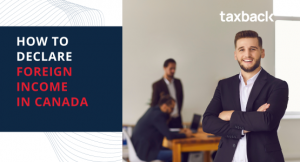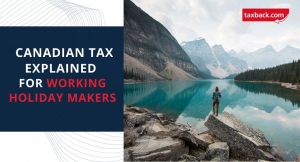The Single Most Important Thing You Need to Know when Paying Tax in Canada
Sometimes it’s hard to keep on top of tax legislation in your own country.
We know taxes can be drag….so we totally understand that when you’re travelling it’s not going to be on top of your agenda.
If you work in Canada, you’ll need to file your own tax return.

We’ve summed up the single most important point you need to understand when you start a job in Canada. Why is this important? Because international workers often underpay tax in Canada, meaning they don’t receive a refund at the end of their time here!
So read on to make sure you maximise your Canadian tax refund:
Income tax: Why it’s important and how it’s calculated
All workers in Canada pay tax on income earned – international workers, Canadians, residents, non-residents. You’re all the same in the eyes of the Canadian Revenue Agency (CRA).
There is a tax-free allowance in Canada. In 2016, this amount is $11,474. In short, this means you are able to earn up to this amount without paying tax on your income. However, not everyone is eligible to claim this credit. Your eligibility to claim this credit and how your income tax is calculated is worked out on a tax form called a TD1.
Read the blog: Determining your residency status in Canada
TD1’s, and why you should know what they are

When you start a job in Canada, your employer will usually ask you to fill out some tax forms. The forms in question are called Federal and Provincial personal tax credit forms.
What are they used for?
Employers use these forms to determine the amount of tax to be deducted from your employment income. These forms are very important, and depending on your situation and how you fill them out, they can be the difference between you getting a tax refund and owing tax to the CRA.
They can be easily found online on the CRA website:
The federal form:
The provincial form that you fill out will depend on what province you are working in:
- TD1BC – British Columbia
- TD1AB – Alberta
- TD1ON – Ontario
- TD1SK – Saskatchewan
- TD1MB – Manitoba
- TD1NU – Nunavut
- Quebec – Form TP-1015.3-V, Source Deductions Return
Who should fill a TD1 form?
Normally you’ll be prompted to fill out the TD1 forms, but just so you’re aware; an individual should fill out one of these forms for any of the following reasons:
- If you have a new employer or payer
- If you want to change amounts from previous claimed tax years
- If you want to claim the deduction for living in a prescribed zone or
- If you want to increase the amount of tax deducted at source
The most common reason for filling out this form is when you change employers or start first-time employment in Canada.
How to fill out a TD1 form, and what to look out for:
Be careful not to get tripped up if any of the following applies to you:
1. You were working outside Canada before you came here, either in your home country or another country
2. You are working a couple of jobs at the same time
1. I worked in another country the same year that I came to Canada
If you earned income from another country in the same year you earned income in Canada (i.e. from January to December), you may not be eligible to claim the personal tax credits allowing you to earn tax-free income in Canada. This is when the 90/10 rule comes to play. The CRA will not allow you to earn tax-free income in Canada, if you do not earn 90% of your total income for the year in Canada.
If you will earn 90% of your total income for the year in Canada, then you can claim the credits. But if your foreign income was quite significant (over 10% of your total income), and you don’t think you will make enough income in Canada to dwarf that amount, you will not be eligible to claim the personal tax credits on the TD1 federal or provincial.
You should enter 0 in box 13, and tick No on the Non-Resident question on the TD1 form.
You also should not claim any provincial credits:
2. I’m working more than 1 job at the same time
If you’re working more than 1 job at a time you need to be careful you aren’t claiming your credits twice. You should only claim the personal tax credits once if you are eligible to claim them.
Preferably claim your tax-free credits for the job earns you the most money:
Read the blog: tax facts for international students
Tips to remember, and FAQ’s

1. Know what tax credits you’re eligible to claim. E.g. You should not claim the personal tax credits if you have earned a significant amount before you came to Canada in the same tax year (90/10 rule)
2. If you feel that you have incorrectly claimed tax credits, you can change them at any time. Just print off some new TD1 forms and give them to your employer
3. If you’re unsure if you are going to earn more than 10% of your income outside of Canada for the tax year then we advise you not to claim the credits. The worst thing that can happen is that you will overpay tax and get a nice refund when you file
4. When calculating the 90/10 rule, use the Net income amounts
5. If you know that you will earn over the tax-free threshold ($11,474 for 2016), you should keep receipts for transit passes, medical expenses and work related expenses
Filing your tax return
.jpg)
You should file your tax return after the end of the tax year before the April deadline.
You may even get a tax refund and you can check Taxback.com’s online tax refund calculator to find out how much you’re owed.
What you'll need
To file your tax return you will need your Social Insurance Number (SIN) and your T4 or final payslip.
When to file
You need to wait until mid February the following year to apply for a tax refund. The deadline for filing is April 30.
For example, if you worked from June 2015 until May 2016:
- In February 2016 you can file your tax return for the 2015 tax year
- You can expect to have your tax refund in 16 wks
- In February 2017 file your 2016 tax return.
Will I get a refund?
It really depends on whether or not you overpaid tax!
Tax refunds in Canada come from the overpayment and this is generally broken down to 3 different taxes:
- overpayment of income tax
- overpayment of CPP (Canadian Pension Plan)
- overpayment of EI (Employer Insurance).
One way to find out is to get an estimate using our online tax refund calculator.
If you have any questions or need help please email info@taxback.com.




